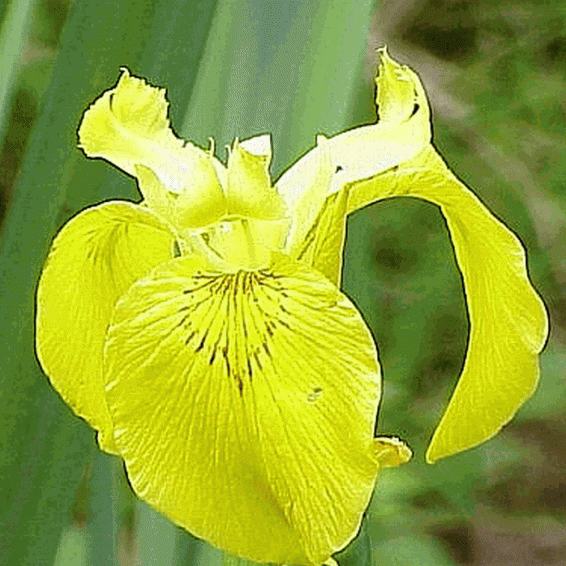Yellow Iris Seeds
Iris pseudacorus
- HOW TO GROW
- FAST FACTS
- REVIEWS
HOW TO GROW
Sowing: To help soften the hard seed coat, soak the seeds overnight in warm water before planting. To germinate, these seeds need a period of several months of cold followed by warmth. To accomplish this naturally, direct sow the seeds in fall; they will begin to germinate in the late spring and early summer. Alternatively, the seed can be store in moist sand in the refrigerator for 60-90 days then planted 1/2" deep in peat pots. For best results, use slightly acidic soil and keep the soil moist and at a temperature of 70-75 degrees F. These seeds germinate rather slowly, often taking several months to sprout. Keep in mind that germination will continue through the first several years, as the seeds gradually come out of dormancy. The seedlings can be planted outdoors in late spring or early summer or when there is no chance of frost, or when they have reached a height of 4-6".
Growing: Seedlings will need frequent watering until they become established. Mature plants perform best in moist soil, and thrive in marshy ground or standing water. These native plants flourish with little attention, and soon form dense colonies that often crowd out other plants. When fully grown, the plants can easily be divided in late fall. Blooming usually begins in the second year after planting. Because of its potentially invasive nature, we cannot sell this plant to customers in CA, CT, IN, MA, MT, NH, OR, or WA.
Harvesting: These blossoms do not perform well as cut flowers, and are best enjoyed outdoors.
Seed Saving: Very soon after blooming, this plant will produce large green pods that quickly turn brown and drop their seed. Gather the pods as soon as the seeds inside have turned brown; spread the pods out to dry completely, then separate the seeds from the husks. Store the cleaned seed in a cool, dry place.
FAST FACTS
Common Names: Pale Yellow Iris, Yellow Flag
Latin Name: Iris pseudacorus
Species Origin: Introduced US Wildflower
Type: Garden Flowers
Life Cycle: Perennial
USDA Zones: 2, 3, 4, 5, 6, 7, 8, 9, 10, 11
US Regions: California, Mountain, Arid/Desert, Plains/Texas, Midwest, Northern, Northeast, Southeast
Seeds per Ounce: 500
Stratification: Cold/Wet for 8 Weeks
Germination Ease: Stratify 8 Weeks
Height: 60 Inches
Uses: Cut Flowers, Deer Resistant
DESCRIPTION
IN-STOCK ORDERS SHIP THE NEXT BUSINESS DAY VIA THE US POST OFFICE.
The word "iris" comes from Greek, meaning "rainbow." The mythical Iris of Greek legend personified the rainbow, acting as the messenger from heaven to earth. This flower also appears in ancient Egyptian sculpture and tradition, as a symbol of life and power. According to traditional legend, the golden fleur-de-lis of France is a stylized version of this yellow iris, which grows wild throughout Europe and the Mediterranean region. It came to North America in the early 20th century, soon establishing itself as an ornamental plant as well as being valuable in erosion control.
HOW TO GROW
Sowing: To help soften the hard seed coat, soak the seeds overnight in warm water before planting. To germinate, these seeds need a period of several months of cold followed by warmth. To accomplish this naturally, direct sow the seeds in fall; they will begin to germinate in the late spring and early summer. Alternatively, the seed can be store in moist sand in the refrigerator for 60-90 days then planted 1/2" deep in peat pots. For best results, use slightly acidic soil and keep the soil moist and at a temperature of 70-75 degrees F. These seeds germinate rather slowly, often taking several months to sprout. Keep in mind that germination will continue through the first several years, as the seeds gradually come out of dormancy. The seedlings can be planted outdoors in late spring or early summer or when there is no chance of frost, or when they have reached a height of 4-6".
Growing: Seedlings will need frequent watering until they become established. Mature plants perform best in moist soil, and thrive in marshy ground or standing water. These native plants flourish with little attention, and soon form dense colonies that often crowd out other plants. When fully grown, the plants can easily be divided in late fall. Blooming usually begins in the second year after planting. Because of its potentially invasive nature, we cannot sell this plant to customers in CA, CT, IN, MA, MT, NH, OR, or WA.
Harvesting: These blossoms do not perform well as cut flowers, and are best enjoyed outdoors.
Seed Saving: Very soon after blooming, this plant will produce large green pods that quickly turn brown and drop their seed. Gather the pods as soon as the seeds inside have turned brown; spread the pods out to dry completely, then separate the seeds from the husks. Store the cleaned seed in a cool, dry place.
FAST FACTS
Common Names: Pale Yellow Iris, Yellow Flag
Latin Name: Iris pseudacorus
Species Origin: Introduced US Wildflower
Type: Garden Flowers
Life Cycle: Perennial
USDA Zones: 2, 3, 4, 5, 6, 7, 8, 9, 10, 11
US Regions: California, Mountain, Arid/Desert, Plains/Texas, Midwest, Northern, Northeast, Southeast
Seeds per Ounce: 500
Stratification: Cold/Wet for 8 Weeks
Germination Ease: Stratify 8 Weeks
Height: 60 Inches
Uses: Cut Flowers, Deer Resistant



